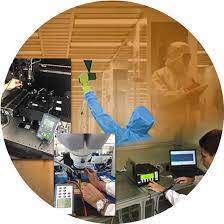Ionizer Necessities Help Keep Place With Strict Rules Safe And Correct
Some of the tools we talk about are ESD testing, static control, and full cleanroom management systems. These help people stay safe, follow the rules, and do their best work.
An ionizer – electrostatic discharge
One of the biggest risks in clean and controlled areas is static energy. Static electricity can damage delicate parts, attract dust, and make it hard to do specific jobs. This is where an oxidizer comes in handy.
What does an oxidizer do?
Ions stick to charged objects and stop static electricity from building up.
You can use an ionizer for:
- Labs and cleanrooms
- Making medical devices
- Semiconductor assembly lines
- Making electronics
By keeping the environment neutral, ionizers help lower the chance of electrostatic discharge (ESD). This increases yields and keeps expensive parts safe.
Different Types of Important ESD Tests
For example, the wrist strap and footwear tester check to see if a person is grounded. The surface resistance measurement checks how static moves through materials. The simulated discharge testing checks to see how well a product can handle controlled electric pulses.
Qualifying the room or area makes sure that all places meet ESD safety standards
Companies that do regular ESD testing can find and fix weak spots before they become problems. It is very important to do this in areas where small problems can have big effects, like medical electronics and aircraft electronics.
The key to ESD safety is static control
Static control includes the ways, tools, and practices used to keep static electricity in check and get rid of it in public places. Without it, electrostatic buildup can stop things from working, lose data, make goods not work right, or even start fires in places where they could explode.
Here are some good ways to get rid of static:
Properly grounding all equipment and workspaces
Controlling humidity is important because dry air makes static electricity more likely. Ionizer tools get rid of charges in the air.
People and things can be kept safe from electrostatic shocks by controlling static electricity and testing for ESD often.
Safety Cabinet: Keeps secret processes inside to keep them safe
A safety cabinet is a controlled area in a lab or workplace where important or dangerous work can be done without risk. There are safety cabinets for drugs, biohazards, and sensitive electronics. These cabinets keep people and things clean and out of the way.
For ESD work cabinets, make sure that parts are safe from electrostatic discharge while they are being handled or stored. For clean bench cabinets, make sure that air can move easily through the cabinets so that cleanroom tasks can be done.
It is important to keep safety cabinets in good shape and test them for cooling to make sure they still meet standards like NSF/ANSI 49 and keep people safe.
Cleanroom Testing: Keeping an eye on and reducing dirt and germs
A cleanroom testing is a set of steps that are used to make sure that cleanrooms are clean and working properly.
Why it’s significant:
- Makes sure that international safety and quality standards are met
- Raise the trustworthiness of products and the number of customers who buy them
- Help with regulatory checks and certifications
- Promotes worker safety and operational excellence
Conclusion
A tidy, secure, and static-free job is very important in today’s high-tech environment. You can protect your business, make sure it follows the rules, and make sure it is safe by getting an ionizer, testing for ESD, utilizing safe boxes, and doing thorough cleanroom testing. Now is the time to build a solid safety infrastructure so that your upcoming biotech, pharmaceutical, or electronics breakthroughs will be safe.
Some of the tools we talk about are ESD testing, static control, and full cleanroom management systems. These help people stay safe, follow the rules, and do their best work.
An ionizer – electrostatic discharge
One of the biggest risks in clean and controlled areas is static energy. Static electricity can damage delicate parts, attract dust, and make it hard to do specific jobs. This is where an oxidizer comes in handy.
What does an oxidizer do?
Ions stick to charged objects and stop static electricity from building up.
You can use an ionizer for:
• Labs and cleanrooms
• Making medical devices
• Semiconductor assembly lines
• Making electronics
By keeping the environment neutral, ionizers help lower the chance of electrostatic discharge (ESD). This increases yields and keeps expensive parts safe.
Different Types of Important ESD Tests
For example, the wrist strap and footwear tester check to see if a person is grounded. The surface resistance measurement checks how static moves through materials. The simulated discharge testing checks to see how well a product can handle controlled electric pulses.
Qualifying the room or area makes sure that all places meet ESD safety standards
Companies that do regular ESD testing can find and fix weak spots before they become problems. It is very important to do this in areas where small problems can have big effects, like medical electronics and aircraft electronics.
The key to ESD safety is static control
Static control includes the ways, tools, and practices used to keep static electricity in check and get rid of it in public places. Without it, electrostatic buildup can stop things from working, lose data, make goods not work right, or even start fires in places where they could explode.
Here are some good ways to get rid of static:
Properly grounding all equipment and workspaces
Controlling humidity is important because dry air makes static electricity more likely. Ionization tools get rid of charges in the air.
People and things can be kept safe from electrostatic shocks by controlling static electricity and testing for ESD often.
Safety Cabinet: Keeps secret processes inside to keep them safe
A safety cabinet is a controlled area in a lab or workplace where important or dangerous work can be done without risk. There are safety cabinets for drugs, biohazards, and sensitive electronics. These cabinets keep people and things clean and out of the way.
For ESD work cabinets, make sure that parts are safe from electrostatic discharge while they are being handled or stored. For clean bench cabinets, make sure that air can move easily through the cabinets so that cleanroom tasks can be done.
It is important to keep safety cabinets in good shape and test them for cooling to make sure they still meet standards like NSF/ANSI 49 and keep people safe.
Cleanroom Testing: Keeping an eye on and reducing dirt and germs
A cleanroom testing is a set of steps that are used to make sure that cleanrooms are clean and working properly.
Why it’s significant:
• Makes sure that international safety and quality standards are met
• Raise the trustworthiness of products and the number of customers who buy them
• Help with regulatory checks and certifications
• Promotes worker safety and operational excellence
Conclusion
A tidy, secure, and static-free job is very important in today’s high-tech environment. You can protect your business, make sure it follows the rules, and make sure it is safe by getting an ionizer, testing for ESD, utilizing safe boxes, and doing thorough cleanroom testing. Now is the time to build a solid safety infrastructure so that your upcoming biotech, pharmaceutical, or electronics breakthroughs will be safe.





















Post Comment